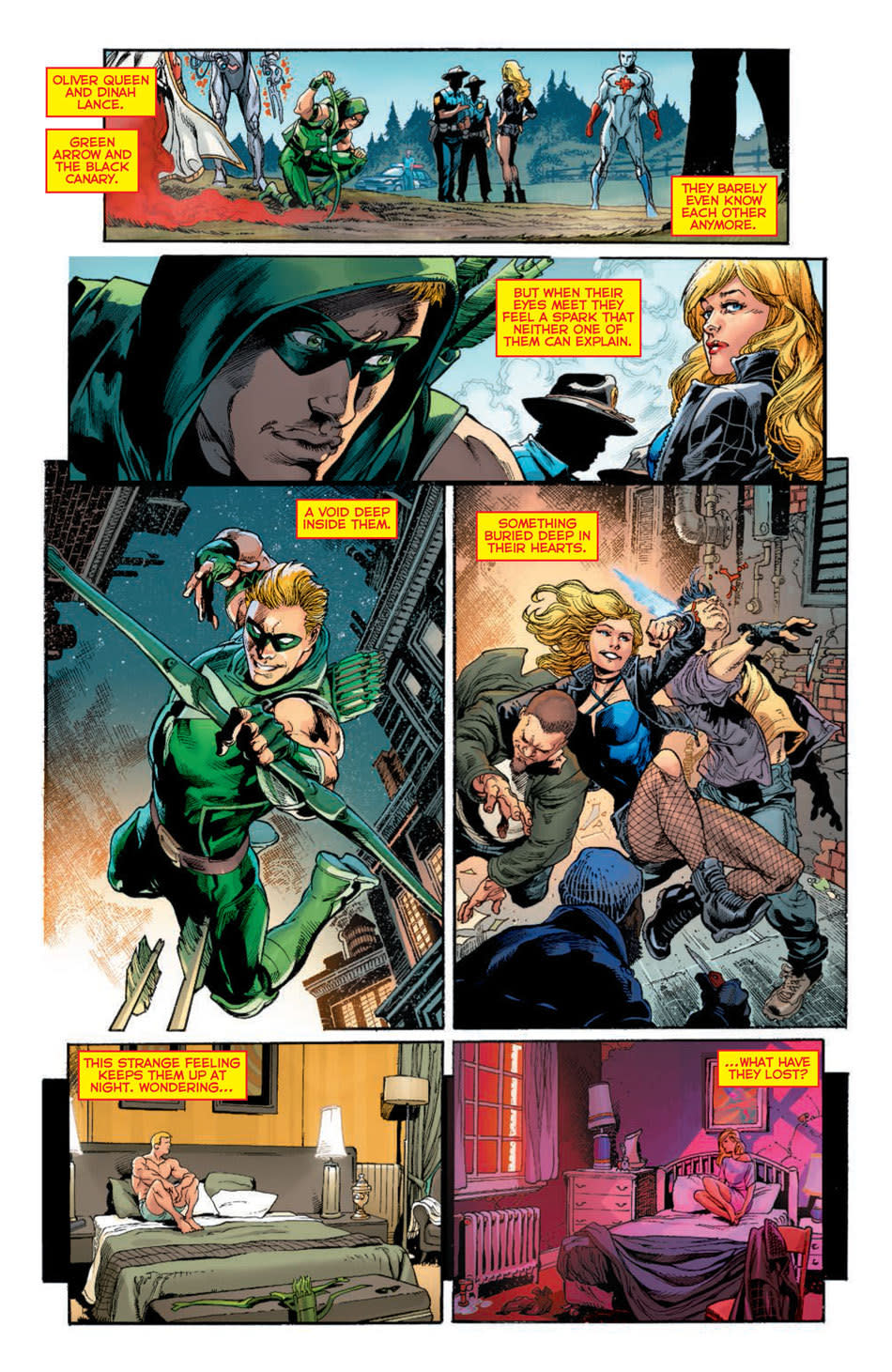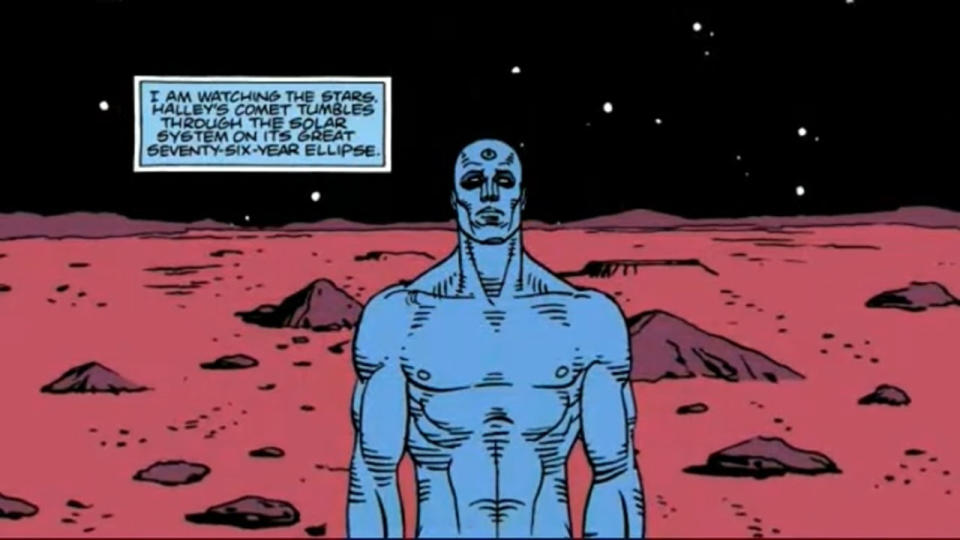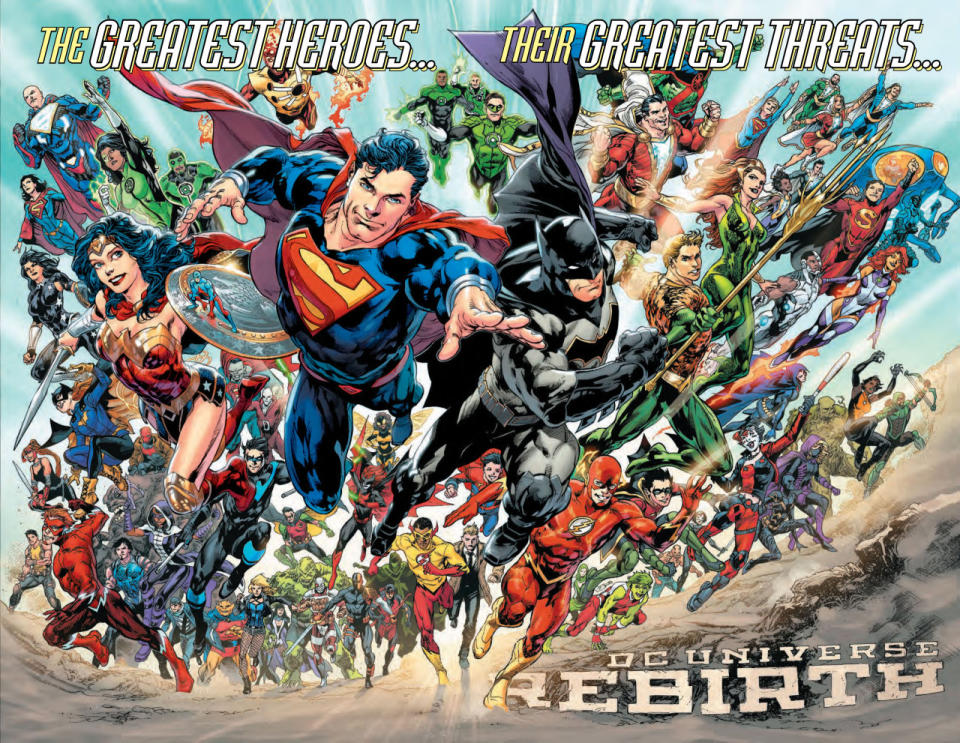DC Mastermind Geoff Johns on Spoilers, Lost Characters and His Universe's 'Rebirth'

This story contains images and plot points from Rebirth. Please stop reading if you want to remain unspoiled.
For a master of the universe, Geoff Johns is surprisingly chill, roaming DC Entertainment’s headquarters outfitted in a T-shirt and jeans under the guise of mild-mannered comics guy.
But once we decamp to his secret lair on the second floor, a temple of DC-related relics guaranteed to make fanboys salivate, there’s no doubt of his alter ego: Chief Creative Officer, the self-professed super fan who holds sway over the superhero landscape. Johns, a boyish 43, has been the architect of DC’s television portfolio, which includes Arrow, Flash, and Supergirl. Last week, he was elevated to the top of DC Films, putting him and Warner Bros. executive Jon Berg in charge of fixing DC’s cinematic universe post-Batman v Superman: Dawn of Justice. And this week, Johns is asserting his creative vision for the venerable publisher in a major way with Rebirth, a one-shot special that recalibrates DC Comics.
Rebirth, hitting stands this week, finds Wally West, the original Kid Flash and onetime Flash, who has been absent from the pages of DC for the past five years, struggling to get back to Earth. He has been trapped in the Speed Force, a kind of an alternate dimension that powers DC’s speedsters, where he learned that something has affected the events of his home world, robbing the heroes of 10 years of their lives.

He desperately tries to make contact with various characters — including Batman, old-timer Johnny Thunder of the Justice Society, and Barry Allen, the Silver Age Flash — needing to establish a physical connection or else be lost to the Speed Force forever. Over the course of the 90-page book, Wally also gets up to speed on events on Earth involving Superman (who’s MIA), Aquaman, Green Arrow, a new Green Lantern, the Atom, and Blue Beetle. The end of the story delivers a jaw-dropping twist that will have implications for years to come.

Johns says he was approached by DC co-publishers Dan DiDio and Jim Lee last October and asked to take on Rebirth. The concept was to reestablish the breadth of the comics universe after its fragmentation following 2011’s “New 52” reboot. That initiative, while incredibly popular commercially, sidelined or completely revamped several classic heroes (such as the vintage Wally West), created new origin stories for others, and generally ignored much of DC’s history. DC has been moving away from the New 52 branding over the past year and Rebirth officially signifies a new epoch for the publisher.
“It’s a tonal shift,” says Johns, who was initially hesitant to take on the project. “I just wanted to establish a general compass for the universe. That doesn’t mean the path is narrow — it’s very, very wide. The universe has a thematic DNA that is true to what DC is at its core, and that is hope and optimism. That doesn’t mean that we won’t have characters that are darker or threats that will challenge that ideal, but the pervasive attitude of the heroes is hope and optimism. Even Batman wouldn’t keep fighting if he didn’t believe tomorrow wouldn’t be better.”
After signing up for Rebirth, Johns says it took several months to develop the comic. He spent hours in the writers room laying out the key tenets of the new books.
“Hope. Legacy. Optimism. History. Epic storytelling. Cosmic threats. The great iconic heroes and villains… The periodic table of DC,” he says. “People should be able to jump right in. Everything is back to essence. What I didn’t want to do is reboot history, because I didn’t think that was necessary.
“People also like cohesion. That doesn’t mean all the books tie together or this one crosses over into that one. It means that they live and breathe in the same universe. Those things for me were missing, and I wanted to figure out how we could re-orient the universe with those core elements.”

He also knew he wanted to bring back “a lot of concepts and characters that have have been gone for a while. Like the Justice Society of America. And Rebirth is about reintroducing them.” He points to one terrific sequence, in which the elderly Johnny Thunder, a former member of the Justice Society (DC’s all-star superhero team that predated the Justice League), tries to break out of his nursing home. “The retirement home is a metaphor for what happened to the older heroes. It felt like we weren’t allowed to use older characters [in the New 52]. And they were locked away and they were stuck and they desperately wanted to be out. All these heroes want to be used. I really believe that. So Johnny Thunder wants to get the heck out of that retirement home.”
While it’s obvious that Wally West serves as a surrogate for the audience in Rebirth, guiding us through the new reality, it becomes clear talking to Johns that the hopeful, optimistic West might also be a proxy for the author. So I ask him.

“He was my favorite character growing up. This is probably the most meta comic I’ve written in a while,” Johns responds. “I’ve always loved Batman, Superman, Wonder Woman, but I’ve always loved the other guys, too. I loved the Atom. I loved Batgirl. All the characters that were the second, third, fourth tier…from the Metal Men to Mera to Metamorpho. What I want to do is take the characters that people overlook and say, ‘Look, these characters have value.’
“Wally West has as much passion and love for the DC Universe as I do, so yes, he’s definitely a stand-in for me. This is probably the most personal story I’ve written about comics in a long, long time. It’s my love letter to the DC Universe.”

The problem with love letters, though, is sometimes they get hijacked before reaching their intended audience. Such was the case with Rebirth. Although the book wasn’t slated for release until Tuesday, early copies leaked on Reddit late last week, with scanned pages revealing several surprising plot points, including the revelation that the original Wally West was still kicking around.
Then there was the reveal that Batman might be dealing with three different Jokers. (“There is more to the Joker than Batman realizes. He doesn’t know what that means,” Johns says cryptically. “It could mean that there are literally three, or it could mean something else.”)
Finally, we learned that the entire DC Universe was being manipulated by Doctor Manhattan — the near-omnipotent member of the classic Watchmen comic. Until now, Watchmen had existed in a separate reality from DC’s, but that’s no longer the case.
“Why is the universe different? Because somebody stole time from it. It wasn’t just time, it was love. I wanted to reveal that there was a threat behind it all and they did it for a reason. They are challenging love. They are challenging optimism. They are challenging hope. I wanted a character that had the power to do that and I wanted a character that was a surprise and interesting and would make people think. And that’s why I chose Doctor Manhattan. He’s a personification of all that. I don’t call him a villain. I call him more of an antagonist or an entity because he’s so far removed from humanity.”

Johns worked really hard to keep his ending from getting out before the book was available to the public. “[Artist] Gary Frank and I had to secretly do these pages because we didn’t want anyone to see them. They were uploaded on a different server. The fact that we kept this a secret until four or five days before it came out was pretty good,” he says, acknowledging that navigating spoiler-based sites are part of the game. “It’s always a bummer. But it’s the day and age that we live in. The fact that people cared about what happens in Rebirth shows just how much they are invested in it… I cut my heart out and put it into this book.”
Now that Rebirth is out, Johns is taking a hiatus from writing. “I wanted to set this special up, work with the other writers and editors and then let them go off and do their thing. I’ll take a step back from comics for a while and focus on some other stuff,” he says.
That “other stuff” obviously includes movies. Johns will be helping to drive future DC-based films following BvS’s critical lashing and inability to attain the billion-dollar box office of Marvel’s Avengers films and current Captain America: Civil War.
During our conversation, Johns repeatedly insisted he couldn’t talk about his role at DC Films or upcoming films like Suicide Squad, Wonder Woman, and Justice League. But it’s not a stretch to see how his philosophy for DC Comics and Rebirth might apply to the cinematic universe. Warner Bros., which owns DC and produces the DC movies, has been public about its desire to empower directors of each installment to put their personal stamp on the films — unlike Marvel where the filmmakers serve as an extension of production chief Kevin Feige. That jibes with Johns’s approach to the books.
“You don’t want to micromanage a universe and you can’t ever put rules on a DC Universe. When they try to do that, I don’t think it works because it limits the possibilities of story and character,” he says. “We’ve got to do this right. it’s sitting down in the writers room, talking about these characters, brainstorming ideas… it’s all about character. And then we talk about what story will highlight various aspects of this character.
“Then the creative teams go off and run with them. It’s up to the individual creators to make their work soar and sing. And we just wanted a very open, but directed compass on the universe. My compass is pointing toward heroism. I like celebrating heroes. I like heroes that try and succeed. They may fail, but they’ll try again.”

Perhaps it’s telling that Johns’s favorite comic growing up was The Flash and that the recent DC Films shakeup saw the departure of director Seth Grahame-Smith, who was set to helm the feature-film version.
While he declined to specifically talk about the movies, Johns did note that the three parts of DC — the comics, movies, and TV shows — all have to exist on their own merits. “The comics have to be the comics. If there’s synergy there’s synergy. If there are good ideas that goes back and forth, great… There are some aspects from other media that might work. And when they work, cool. It would be foolish not to integrate them. Certainly the goal is not to make these mirror the films or the TV shows. I want to do stuff in comics that we can’t do anywhere else, which is why I chose Doctor Manhattan. That can only be a comic-book story.”
Rebirth is now available at comic shops and via digital services.
All images courtesy of DC Entertainment.

